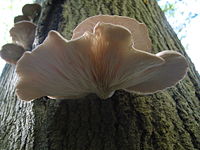
Photo from wikipedia
Beijing experienced a period of severe atmospheric particulate pollution from 2015 to 2016. In order to acquire the characteristics of polycyclic aromatic hydrocarbons (PAHs) under heavy polluting status, one year… Click to show full abstract
Beijing experienced a period of severe atmospheric particulate pollution from 2015 to 2016. In order to acquire the characteristics of polycyclic aromatic hydrocarbons (PAHs) under heavy polluting status, one year sampling campaign was carried out. We selected PM2.5 samples which had the highest concentrations or suffered serious haze-fog weathers in each month. Through the analysis of data from heavily polluting phase, the mean concentrations of PM2.5 and PAHs in winter (369.63 μg m-3 and 223.60 ng m-3) were obviously higher than that in other seasons. The concentration of Σ16PAHs ranged from 3.22 to 297.01 ng m-3, with a mean value of 77.48 ng m-3. In winter, 4-ring PAH congeners (52.33%) contributed the most in PM2.5, followed by 5-rings (27.05%), 6-rings (11.55%) and 2∼3-rings (9.06%). Summertime measurements showed the highest decline in PAHs concentrations for 3∼5-ring congeners. The diagnostic ratios and PCA analysis manifest that vehicle and combustion emission were major sources and totally occupied 88.57% under heavy polluting stage. Moreover, exponential relationship between LWM/HWM (light/high weight molecule-PAHs) and combustion-derived PAHs, as well as linear relationship between BghiP and ∑PAHs verified that the pollution sources mentioned above affected local atmosphere environment as major sources. The highest total BaP equivalent concentration suggested that toxicity potency under heavy polluting phase was mainly attributed to 5-ring PAHs. Through analysis of carcinogenic-PAHs, potency risk to adults was significantly higher than that to children. BaP, BbF and DahA, which belong to 5-ring congeners, contributed the highest potency carcinogenic risk. BbF in winter, BaP in spring and winter may cause potential risk to local residents.
Journal Title: Chemosphere
Year Published: 2018
Link to full text (if available)
Share on Social Media: Sign Up to like & get
recommendations!